Moroccan vs Czechoslovakian Community Comparison
COMPARE
Moroccan
Czechoslovakian
Social Comparison
Social Comparison
Moroccans
Czechoslovakians
3,626
SOCIAL INDEX
33.8/ 100
SOCIAL RATING
215th/ 347
SOCIAL RANK
7,027
SOCIAL INDEX
67.8/ 100
SOCIAL RATING
132nd/ 347
SOCIAL RANK
Czechoslovakian Integration in Moroccan Communities
The statistical analysis conducted on geographies consisting of 165,449,568 people shows a moderate positive correlation between the proportion of Czechoslovakians within Moroccan communities in the United States with a correlation coefficient (R) of 0.478. On average, for every 1% (one percent) increase in Moroccans within a typical geography, there is an increase of 0.089% in Czechoslovakians. To illustrate, in a geography comprising of 100,000 individuals, a rise of 1,000 Moroccans corresponds to an increase of 88.8 Czechoslovakians.
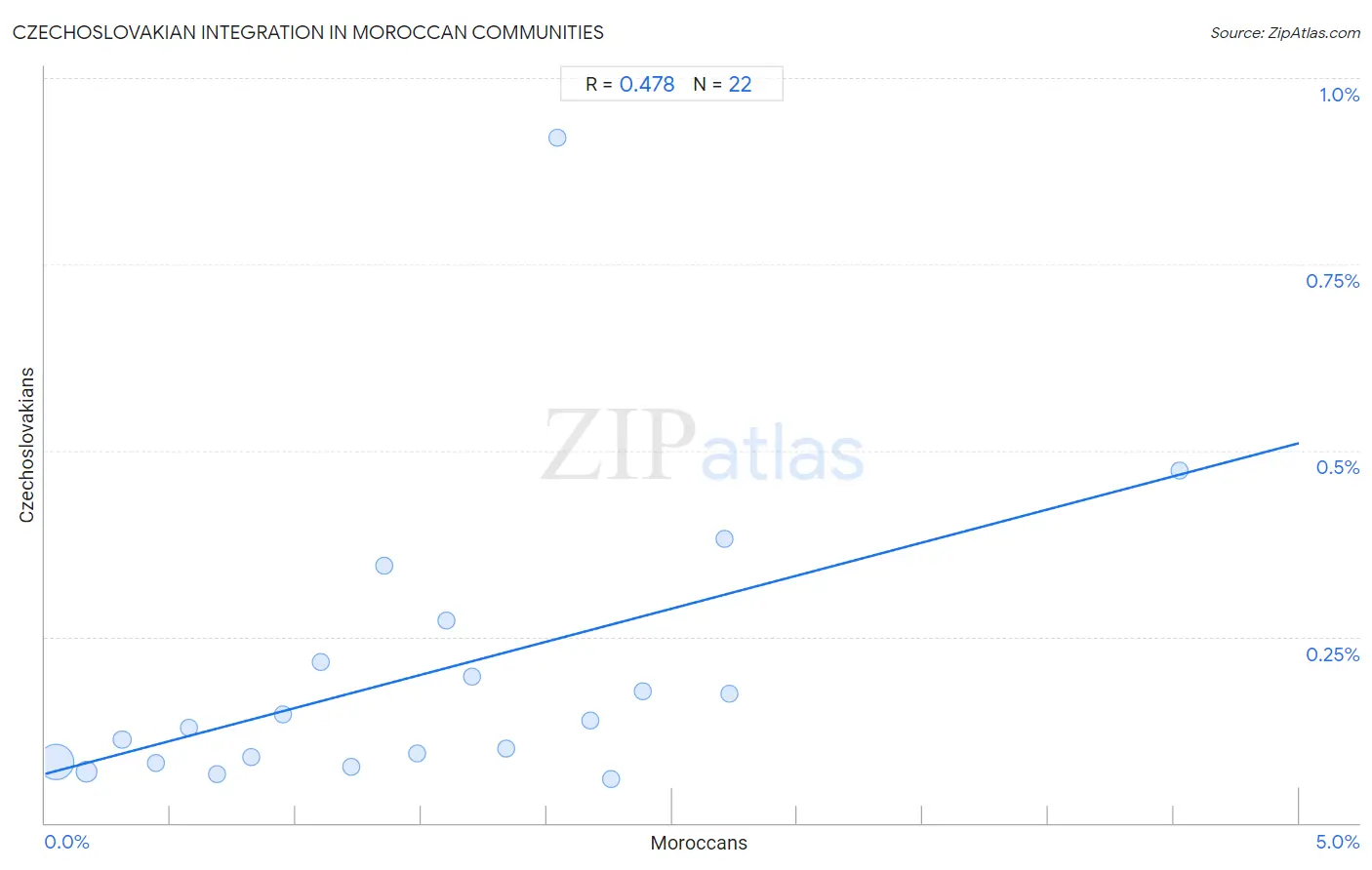
Moroccan vs Czechoslovakian Income
When considering income, the most significant differences between Moroccan and Czechoslovakian communities in the United States are seen in wage/income gap (24.0% compared to 28.2%, a difference of 17.6%), median female earnings ($41,872 compared to $38,738, a difference of 8.1%), and per capita income ($45,854 compared to $43,806, a difference of 4.7%). Conversely, both communities are more comparable in terms of householder income ages 25 - 44 years ($96,117 compared to $95,070, a difference of 1.1%), median family income ($104,488 compared to $103,273, a difference of 1.2%), and householder income ages 45 - 64 years ($100,138 compared to $101,387, a difference of 1.3%).

| Income Metric | Moroccan | Czechoslovakian |
| Per Capita Income | Exceptional $45,854 | Average $43,806 |
| Median Family Income | Good $104,488 | Average $103,273 |
| Median Household Income | Good $86,468 | Average $84,965 |
| Median Earnings | Exceptional $48,838 | Average $46,658 |
| Median Male Earnings | Excellent $56,499 | Good $55,382 |
| Median Female Earnings | Exceptional $41,872 | Poor $38,738 |
| Householder Age | Under 25 years | Exceptional $53,256 | Tragic $51,224 |
| Householder Age | 25 - 44 years | Good $96,117 | Average $95,070 |
| Householder Age | 45 - 64 years | Average $100,138 | Good $101,387 |
| Householder Age | Over 65 years | Fair $59,683 | Average $60,581 |
| Wage/Income Gap | Exceptional 24.0% | Tragic 28.2% |
Moroccan vs Czechoslovakian Poverty
When considering poverty, the most significant differences between Moroccan and Czechoslovakian communities in the United States are seen in married-couple family poverty (5.7% compared to 4.4%, a difference of 30.3%), seniors poverty over the age of 65 (12.0% compared to 9.5%, a difference of 26.9%), and receiving food stamps (12.8% compared to 10.3%, a difference of 24.1%). Conversely, both communities are more comparable in terms of single father poverty (17.0% compared to 17.1%, a difference of 0.52%), single mother poverty (29.5% compared to 29.7%, a difference of 0.87%), and female poverty among 25-34 year olds (13.8% compared to 13.7%, a difference of 1.1%).
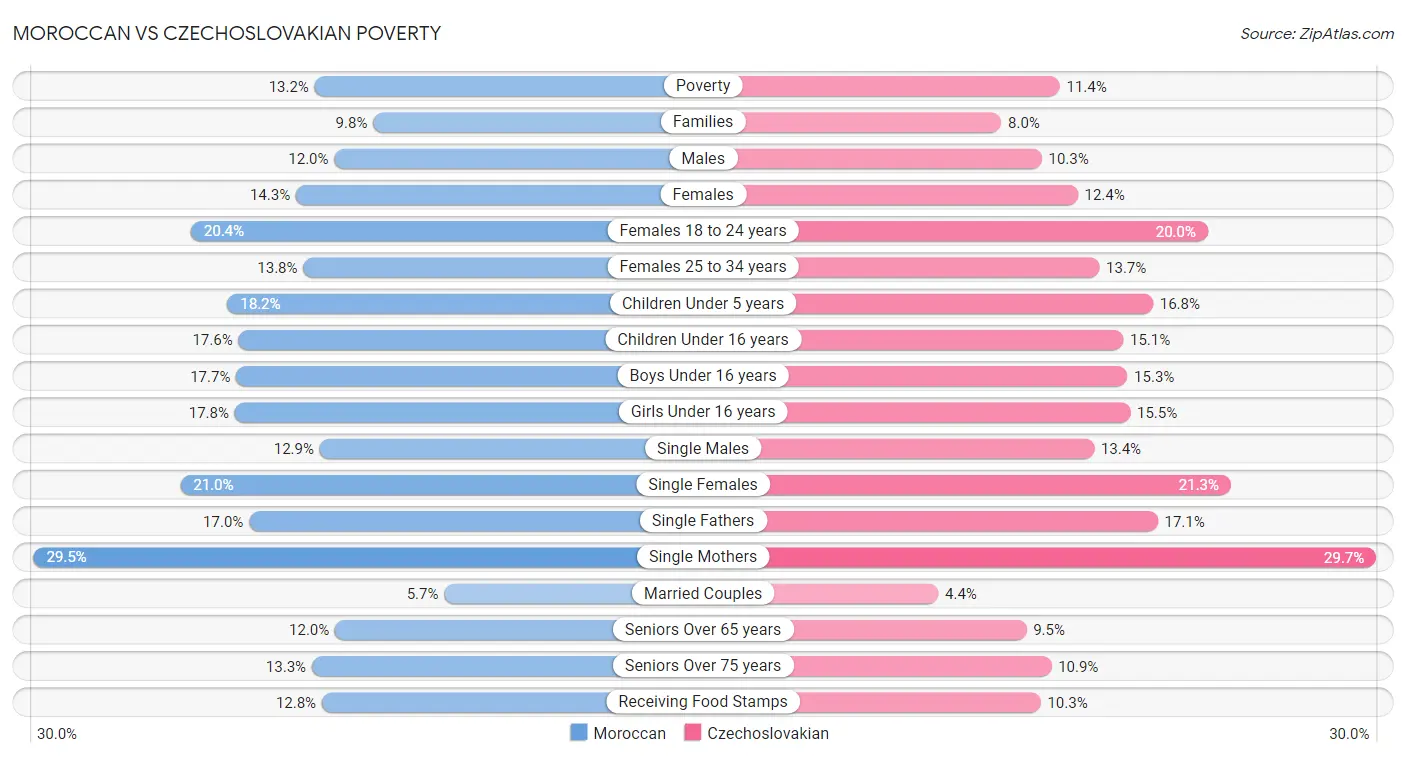
| Poverty Metric | Moroccan | Czechoslovakian |
| Poverty | Tragic 13.2% | Exceptional 11.4% |
| Families | Tragic 9.8% | Exceptional 8.0% |
| Males | Tragic 12.0% | Exceptional 10.3% |
| Females | Tragic 14.3% | Exceptional 12.4% |
| Females 18 to 24 years | Fair 20.4% | Good 20.0% |
| Females 25 to 34 years | Fair 13.8% | Fair 13.7% |
| Children Under 5 years | Tragic 18.2% | Good 16.8% |
| Children Under 16 years | Tragic 17.6% | Exceptional 15.1% |
| Boys Under 16 years | Tragic 17.7% | Exceptional 15.3% |
| Girls Under 16 years | Tragic 17.8% | Excellent 15.5% |
| Single Males | Fair 12.9% | Tragic 13.4% |
| Single Females | Average 21.0% | Fair 21.3% |
| Single Fathers | Tragic 17.0% | Tragic 17.1% |
| Single Mothers | Fair 29.5% | Poor 29.7% |
| Married Couples | Tragic 5.7% | Exceptional 4.4% |
| Seniors Over 65 years | Tragic 12.0% | Exceptional 9.5% |
| Seniors Over 75 years | Tragic 13.3% | Exceptional 10.9% |
| Receiving Food Stamps | Tragic 12.8% | Exceptional 10.3% |
Moroccan vs Czechoslovakian Unemployment
When considering unemployment, the most significant differences between Moroccan and Czechoslovakian communities in the United States are seen in unemployment among seniors over 75 years (7.8% compared to 9.4%, a difference of 20.6%), unemployment (5.5% compared to 4.8%, a difference of 15.7%), and unemployment among women with children under 18 years (5.9% compared to 5.1%, a difference of 15.6%). Conversely, both communities are more comparable in terms of unemployment among ages 25 to 29 years (6.7% compared to 6.7%, a difference of 0.31%), unemployment among women with children ages 6 to 17 years (8.9% compared to 9.1%, a difference of 1.9%), and unemployment among ages 30 to 34 years (5.5% compared to 5.4%, a difference of 2.4%).
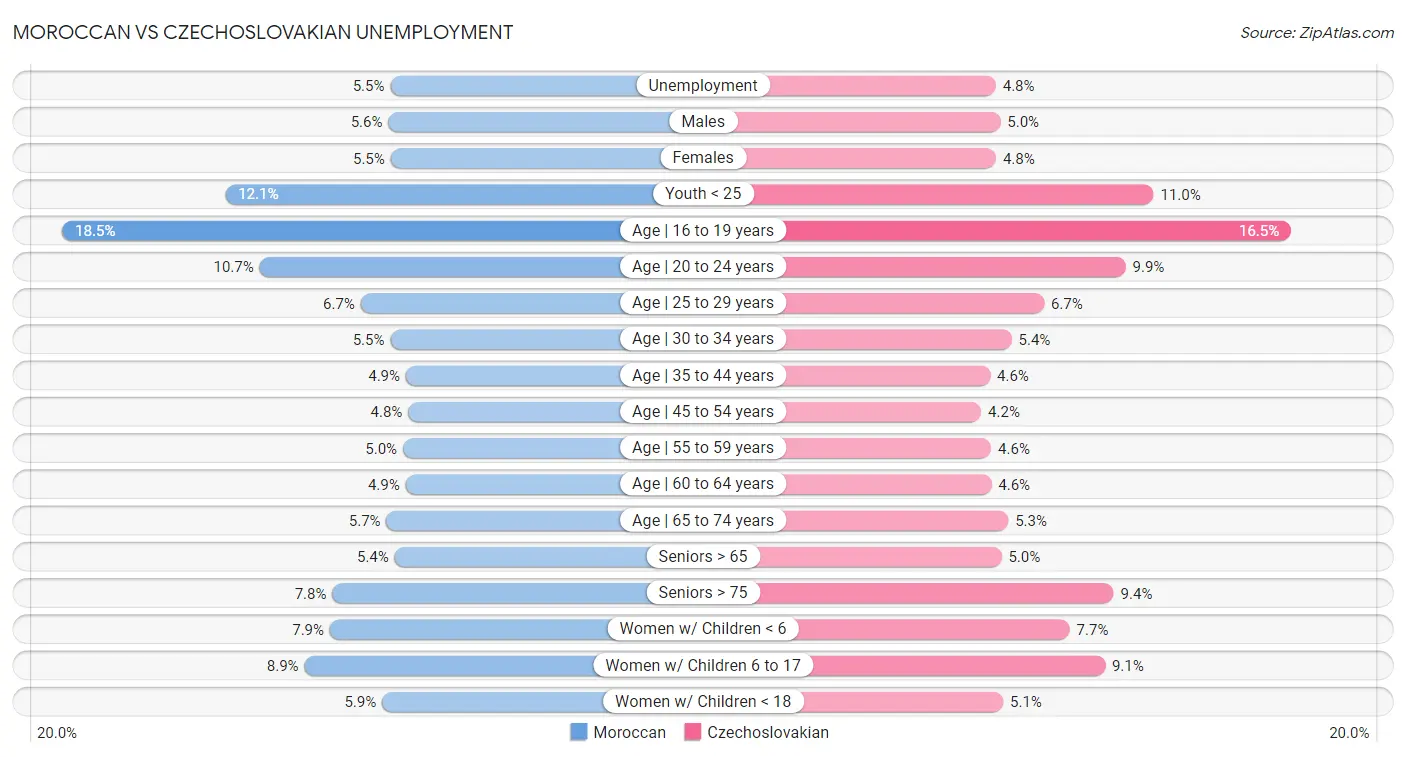
| Unemployment Metric | Moroccan | Czechoslovakian |
| Unemployment | Tragic 5.5% | Exceptional 4.8% |
| Males | Tragic 5.6% | Exceptional 5.0% |
| Females | Tragic 5.5% | Exceptional 4.8% |
| Youth < 25 | Tragic 12.1% | Exceptional 11.0% |
| Age | 16 to 19 years | Tragic 18.5% | Exceptional 16.5% |
| Age | 20 to 24 years | Tragic 10.7% | Exceptional 9.9% |
| Age | 25 to 29 years | Fair 6.7% | Average 6.7% |
| Age | 30 to 34 years | Fair 5.5% | Good 5.4% |
| Age | 35 to 44 years | Tragic 4.9% | Excellent 4.6% |
| Age | 45 to 54 years | Tragic 4.8% | Exceptional 4.2% |
| Age | 55 to 59 years | Tragic 5.0% | Exceptional 4.6% |
| Age | 60 to 64 years | Poor 4.9% | Exceptional 4.6% |
| Age | 65 to 74 years | Tragic 5.7% | Excellent 5.3% |
| Seniors > 65 | Tragic 5.4% | Exceptional 5.0% |
| Seniors > 75 | Exceptional 7.8% | Tragic 9.4% |
| Women w/ Children < 6 | Tragic 7.9% | Fair 7.7% |
| Women w/ Children 6 to 17 | Average 8.9% | Fair 9.1% |
| Women w/ Children < 18 | Tragic 5.9% | Exceptional 5.1% |
Moroccan vs Czechoslovakian Labor Participation
When considering labor participation, the most significant differences between Moroccan and Czechoslovakian communities in the United States are seen in in labor force | age 16-19 (35.7% compared to 41.9%, a difference of 17.4%), in labor force | age 20-24 (74.7% compared to 77.5%, a difference of 3.8%), and in labor force | age > 16 (66.1% compared to 64.3%, a difference of 2.7%). Conversely, both communities are more comparable in terms of in labor force | age 30-34 (84.6% compared to 84.8%, a difference of 0.16%), in labor force | age 20-64 (79.7% compared to 79.5%, a difference of 0.19%), and in labor force | age 35-44 (84.2% compared to 84.6%, a difference of 0.45%).

| Labor Participation Metric | Moroccan | Czechoslovakian |
| In Labor Force | Age > 16 | Exceptional 66.1% | Tragic 64.3% |
| In Labor Force | Age 20-64 | Good 79.7% | Average 79.5% |
| In Labor Force | Age 16-19 | Poor 35.7% | Exceptional 41.9% |
| In Labor Force | Age 20-24 | Fair 74.7% | Exceptional 77.5% |
| In Labor Force | Age 25-29 | Fair 84.5% | Exceptional 85.0% |
| In Labor Force | Age 30-34 | Average 84.6% | Good 84.8% |
| In Labor Force | Age 35-44 | Fair 84.2% | Excellent 84.6% |
| In Labor Force | Age 45-54 | Poor 82.5% | Good 83.0% |
Moroccan vs Czechoslovakian Family Structure
When considering family structure, the most significant differences between Moroccan and Czechoslovakian communities in the United States are seen in single mother households (6.6% compared to 5.9%, a difference of 11.8%), married-couple households (43.5% compared to 48.5%, a difference of 11.6%), and currently married (44.6% compared to 48.8%, a difference of 9.4%). Conversely, both communities are more comparable in terms of family households with children (26.9% compared to 27.0%, a difference of 0.39%), births to unmarried women (31.8% compared to 32.0%, a difference of 0.75%), and divorced or separated (12.1% compared to 12.3%, a difference of 1.2%).

| Family Structure Metric | Moroccan | Czechoslovakian |
| Family Households | Tragic 61.9% | Excellent 64.6% |
| Family Households with Children | Tragic 26.9% | Tragic 27.0% |
| Married-couple Households | Tragic 43.5% | Exceptional 48.5% |
| Average Family Size | Average 3.22 | Tragic 3.13 |
| Single Father Households | Exceptional 2.2% | Average 2.3% |
| Single Mother Households | Poor 6.6% | Exceptional 5.9% |
| Currently Married | Tragic 44.6% | Exceptional 48.8% |
| Divorced or Separated | Fair 12.1% | Poor 12.3% |
| Births to Unmarried Women | Average 31.8% | Fair 32.0% |
Moroccan vs Czechoslovakian Vehicle Availability
When considering vehicle availability, the most significant differences between Moroccan and Czechoslovakian communities in the United States are seen in no vehicles in household (14.7% compared to 7.8%, a difference of 87.3%), 4 or more vehicles in household (4.9% compared to 7.1%, a difference of 44.8%), and 3 or more vehicles in household (15.9% compared to 21.7%, a difference of 36.8%). Conversely, both communities are more comparable in terms of 1 or more vehicles in household (85.4% compared to 92.3%, a difference of 8.1%), 2 or more vehicles in household (48.8% compared to 59.8%, a difference of 22.5%), and 3 or more vehicles in household (15.9% compared to 21.7%, a difference of 36.8%).

| Vehicle Availability Metric | Moroccan | Czechoslovakian |
| No Vehicles Available | Tragic 14.7% | Exceptional 7.8% |
| 1+ Vehicles Available | Tragic 85.4% | Exceptional 92.3% |
| 2+ Vehicles Available | Tragic 48.8% | Exceptional 59.8% |
| 3+ Vehicles Available | Tragic 15.9% | Exceptional 21.7% |
| 4+ Vehicles Available | Tragic 4.9% | Exceptional 7.1% |
Moroccan vs Czechoslovakian Education Level
When considering education level, the most significant differences between Moroccan and Czechoslovakian communities in the United States are seen in no schooling completed (2.2% compared to 1.6%, a difference of 36.9%), professional degree (5.0% compared to 4.2%, a difference of 17.6%), and master's degree (16.8% compared to 14.5%, a difference of 15.6%). Conversely, both communities are more comparable in terms of college, under 1 year (65.6% compared to 65.8%, a difference of 0.27%), nursery school (97.8% compared to 98.5%, a difference of 0.67%), and kindergarten (97.8% compared to 98.4%, a difference of 0.68%).
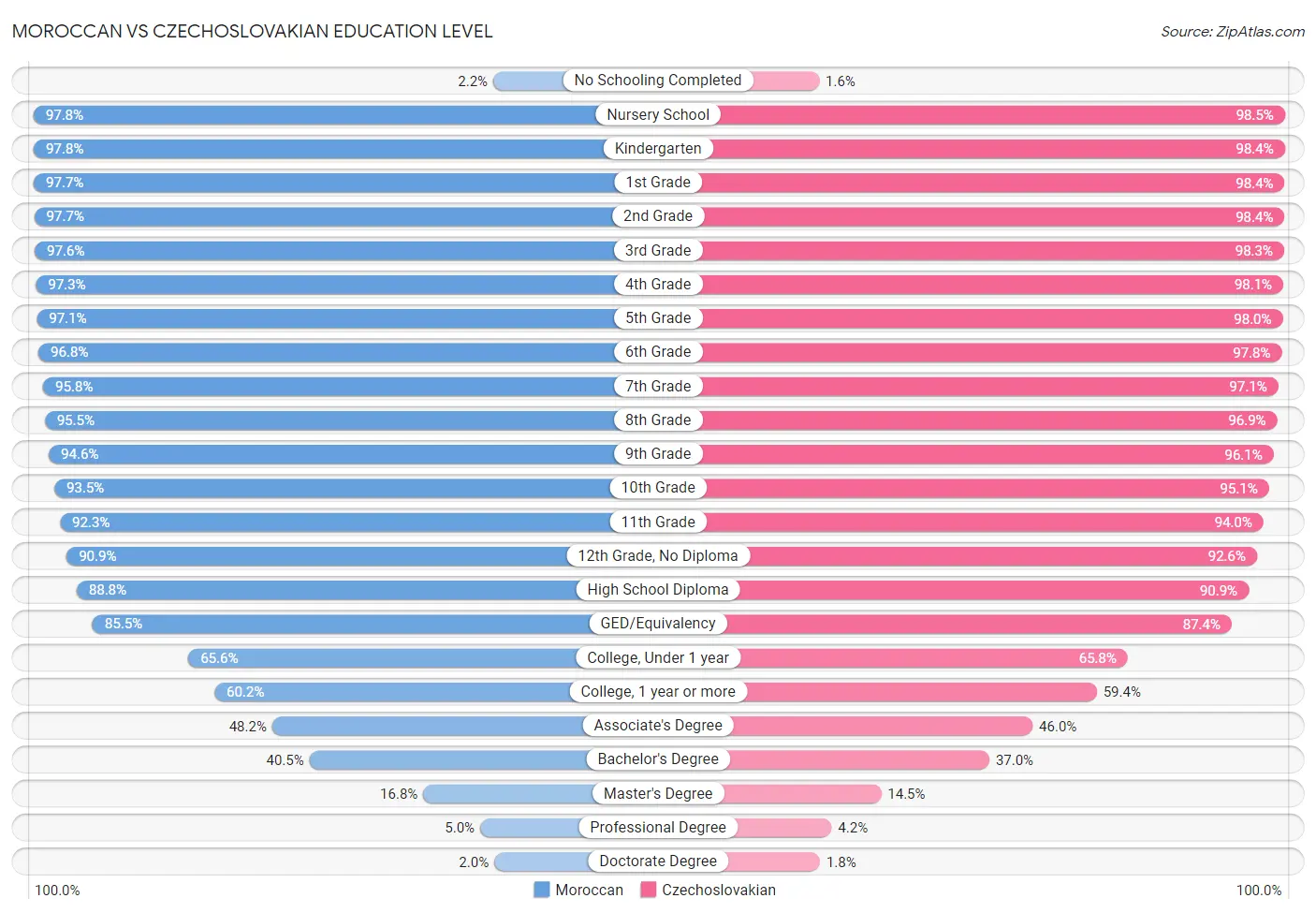
| Education Level Metric | Moroccan | Czechoslovakian |
| No Schooling Completed | Poor 2.2% | Exceptional 1.6% |
| Nursery School | Tragic 97.8% | Exceptional 98.5% |
| Kindergarten | Tragic 97.8% | Exceptional 98.4% |
| 1st Grade | Tragic 97.7% | Exceptional 98.4% |
| 2nd Grade | Tragic 97.7% | Exceptional 98.4% |
| 3rd Grade | Tragic 97.6% | Exceptional 98.3% |
| 4th Grade | Poor 97.3% | Exceptional 98.1% |
| 5th Grade | Poor 97.1% | Exceptional 98.0% |
| 6th Grade | Tragic 96.8% | Exceptional 97.8% |
| 7th Grade | Poor 95.8% | Exceptional 97.1% |
| 8th Grade | Poor 95.5% | Exceptional 96.9% |
| 9th Grade | Poor 94.6% | Exceptional 96.1% |
| 10th Grade | Fair 93.5% | Exceptional 95.1% |
| 11th Grade | Fair 92.3% | Exceptional 94.0% |
| 12th Grade, No Diploma | Fair 90.9% | Exceptional 92.6% |
| High School Diploma | Fair 88.8% | Exceptional 90.9% |
| GED/Equivalency | Fair 85.5% | Exceptional 87.4% |
| College, Under 1 year | Average 65.6% | Good 65.8% |
| College, 1 year or more | Good 60.2% | Average 59.4% |
| Associate's Degree | Excellent 48.2% | Average 46.0% |
| Bachelor's Degree | Exceptional 40.5% | Fair 37.0% |
| Master's Degree | Exceptional 16.8% | Fair 14.5% |
| Professional Degree | Exceptional 5.0% | Fair 4.2% |
| Doctorate Degree | Exceptional 2.0% | Fair 1.8% |
Moroccan vs Czechoslovakian Disability
When considering disability, the most significant differences between Moroccan and Czechoslovakian communities in the United States are seen in hearing disability (2.8% compared to 3.6%, a difference of 26.7%), disability age under 5 (1.2% compared to 1.5%, a difference of 26.6%), and disability age 18 to 34 (6.4% compared to 7.4%, a difference of 16.3%). Conversely, both communities are more comparable in terms of vision disability (2.2% compared to 2.2%, a difference of 1.1%), disability age 65 to 74 (23.3% compared to 23.0%, a difference of 1.2%), and disability age over 75 (47.2% compared to 46.6%, a difference of 1.3%).
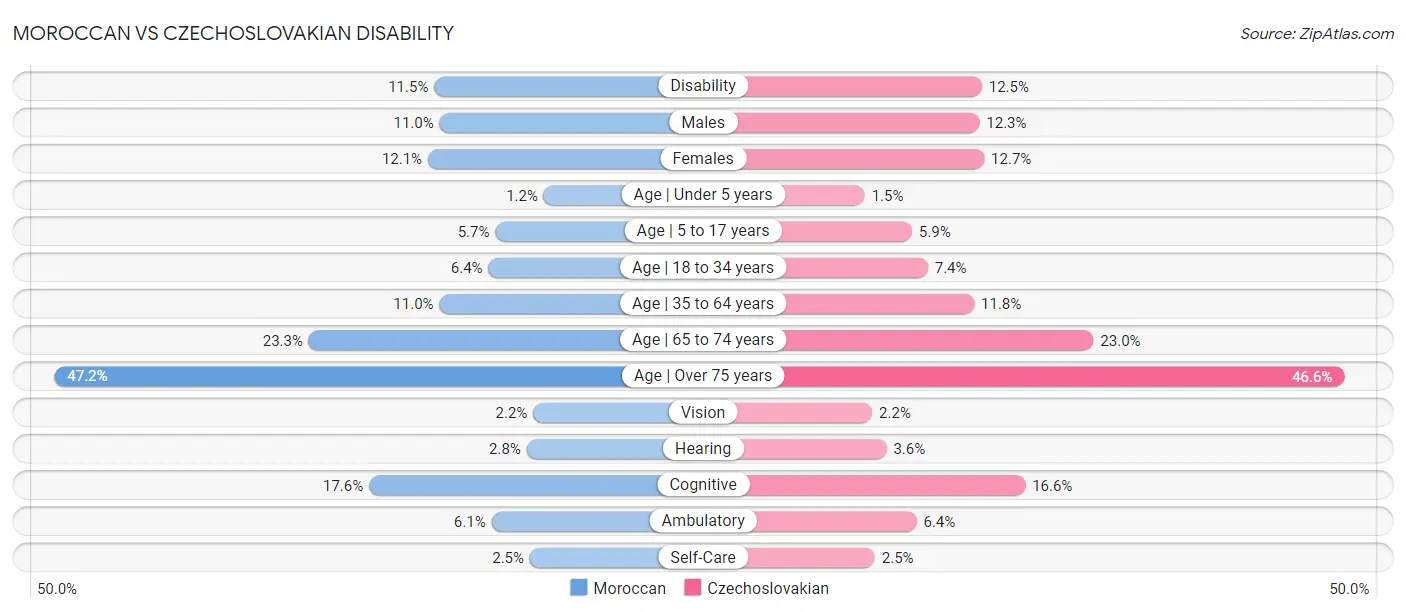
| Disability Metric | Moroccan | Czechoslovakian |
| Disability | Excellent 11.5% | Tragic 12.5% |
| Males | Excellent 11.0% | Tragic 12.3% |
| Females | Good 12.1% | Tragic 12.7% |
| Age | Under 5 years | Excellent 1.2% | Tragic 1.5% |
| Age | 5 to 17 years | Poor 5.7% | Tragic 5.9% |
| Age | 18 to 34 years | Excellent 6.4% | Tragic 7.4% |
| Age | 35 to 64 years | Good 11.0% | Tragic 11.8% |
| Age | 65 to 74 years | Average 23.3% | Good 23.0% |
| Age | Over 75 years | Good 47.2% | Exceptional 46.6% |
| Vision | Fair 2.2% | Fair 2.2% |
| Hearing | Exceptional 2.8% | Tragic 3.6% |
| Cognitive | Tragic 17.6% | Exceptional 16.6% |
| Ambulatory | Average 6.1% | Tragic 6.4% |
| Self-Care | Fair 2.5% | Average 2.5% |